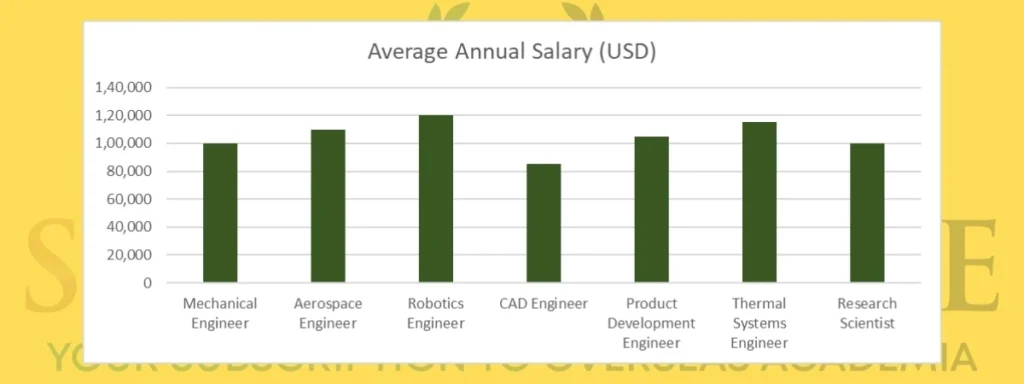The USA is a global leader in mechanical engineering education, offering world-class universities, cutting-edge research, and strong industry connections. Top companies like Tesla, Boeing, GE, SpaceX, and Ford actively recruit graduates from U.S. institutions.
With an average starting salary of $75,000–$85,000, and specialized roles reaching $100,000+, pursuing a Masters in Mechanical Engineering in USA offers strong academic and career returns. This topic covers everything, from top universities and costs to scholarships, admission requirements, and job prospects.
Top 15 Universities for Masters in Mechanical Engineering in USA
The United States stands as a global leader in engineering education, home to institutions that consistently rank among the best worldwide. These universities are celebrated for their advanced research facilities, close ties with leading industries, innovative curricula, and world-class faculty. For aspiring mechanical engineers, studying in the U.S. offers not just academic excellence but also a springboard into high-impact careers.
Here is a carefully curated list of the top 15 universities offering Master’s programs in Mechanical Engineering, along with their global rankings and average annual tuition fees:
| University | Ranking | Annual Tuition (2024–25) |
| Massachusetts Institute of Technology (MIT) | 1 | $55,000 – $60,000 |
| Stanford University | 3 | $60,000 – $62,000 |
| California Institute of Technology (Caltech) | 9 – 10 | $63,000 |
| University of California, Berkeley (UC Berkeley) | 6 | $36,000 – 47,000 |
| Georgia Institute of Technology (Georgia Tech) | 14 | $31,000 – 39,000 |
| Carnegie Mellon University (CMU) | Top 10 nationally in Engineering | $57,000 – 64,000 |
| University of Michigan – Ann Arbor | Top 6 in Aerospace by SHANGHAI | $32,000 – 40,000 |
| University of Texas at Austin (UT Austin) | Ranked 66 nationally | $34,000 |
| University of Illinois Urbana-Champaign (UIUC) | QS Top 15 in MechE nationally | $32,500 – 39,500 |
| University of Southern California (USC) | Top 100 worldwide | $39,500 |
| University of California, San Diego (UCSD) | ARWU #1 US public MechE subject | $30,000 – 35,000 (public rate) |
| Cornell University | QS top 16 engineering | $29,000 – 35,000 |
| Pennsylvania State University (Penn State) | QS top 90 national & global | $24,000 – 30,000 |
| Purdue University | QS top 100 national & global | $32,000 |
| Northwestern University | QS top 50 global | $52,000 |
Suggested Post: Duolingo accepting universities in USA
Top Affordable Universities for MS in Mechanical Engineering in USA
For students looking for quality education at a lower cost, several U.S. public universities offer affordable tuition without compromising academic standards. Here are some of the best-value institutions:
| University | Annual Tuition Fees (USD) | Key Highlights |
| Purdue University | $10,330 – $29,132 | High research output, strong industry connections |
| Texas A&M University | $10,982 – $24,884 | Renowned for mechanical and aerospace engineering |
| University of Texas at Austin | $10,848 – $20,502 | Top-ranked public university with research funding |
| Iowa State University | $13,000 – $25,000 | Hands-on labs and collaborative engineering focus |
| North Carolina State University (NCSU) | $14,000 – $26,000 | Strong ties with automotive and energy sectors |
| Michigan Technological University | $18,000 – $28,000 | Excellent for robotics and materials engineering |
| University of Florida | $15,000 – $30,000 | Great climate + strong academic reputation |
Suggested Post: Masters in cloud computing in USA
Admission Requirements & Eligibility to Study MS in Mechanical Engineering in USA
To gain admission into a Master’s program in Mechanical Engineering in the USA, students must meet both academic and immigration-related requirements:
Academic Eligibility Criteria
| Criteria | Details |
| Academic Qualification | Bachelor’s degree in Mechanical or related field (GPA: 3.0/4.0 or equivalent) |
| GRE | Required for most universities (Minimum score: 300+) |
| English Proficiency | IELTS (6.5+), TOEFL iBT (90+) |
| Letters of Recommendation | 2-3 from academic/professional references |
| Statement of Purpose (SOP) | 1-2 page essay outlining goals and reasons for applying |
| Resume/CV | Highlighting academic and project experience |
Additional Requirements
- Transcripts and academic records (official and translated in English)
- Application form with university-specific requirements
- Application fee (varies from $75 to $125 per university)
Visa Requirements: F-1 Student Visa
Once admitted, international students must apply for an F-1 visa to study in the USA:
Steps to Obtain an F-1 Visa:
- Receive I-20 Form from the university upon acceptance.
- Pay the SEVIS Fee ($350)
- Fill DS-160 Form (Online Non-Immigrant Visa Application).
- Book Visa Appointment at the nearest U.S. Embassy/Consulate.
- Attend Visa Interview with documents: I-20, SEVIS receipt, admission letter, passport, academic records, financial proof.
Visa Interview Tip: Be prepared to explain why you chose the U.S., your academic plans, career goals, and proof of funds.
Financial Proof Required:
- Proof of funds to cover at least the first year’s tuition + living expenses ($40,000–$80,000)
- Bank statements, sponsor letters, scholarships, or assistantship documents
Processing Time:
- I-20 processing: 2–6 weeks after admission
- Visa interview waiting time: 1–4 weeks (varies by country)
Admission Requirements and Process
Here are the admission requirements for Masters in Mechical Engineering in USA:
Academic Prerequisites
Most mechanical engineering graduate programs require:
| Requirement | Details |
| Bachelor’s Degree | Mechanical Engineering or related field (Aerospace, Civil, Electrical) |
| GPA | Minimum 3.0/4.0, competitive programs require 3.5+ |
| Mathematics | Calculus I-III, Differential Equations, Linear Algebra |
| Physics | Mechanics, Thermodynamics, Electricity & Magnetism |
| Core ME Courses | Statics, Dynamics, Thermodynamics, Fluid Mechanics, Heat Transfer |
Standardized Tests
GRE General Test: Most programs require GRE scores, though some have made it optional.
- Quantitative: 160+ (85th percentile)
- Verbal: 150+ (50th percentile)
- Analytical Writing: 4.0+
TOEFL/IELTS (International Students):
- TOEFL iBT: 90+ (top programs require 100+)
- IELTS: 7.0+ (top programs require 7.5
Application Components
- Statement of Purpose: A 500-1000 word essay outlining academic interests, career goals, and reasons for choosing the specific program.
- Letters of Recommendation: Typically 3 letters from professors or industry professionals who can attest to academic and research capabilities.
- Resume/CV: Highlighting academic achievements, research experience, internships, and relevant projects.
- Transcripts: Official transcripts from all post-secondary institutions attended.
- Portfolio (if applicable): For design-focused programs, a portfolio showcasing engineering projects and design work.
Suggested Post: Masters in computer science in USA
Specializations in Masters in Mechanical Engineering in USA

A Master’s in Mechanical Engineering in the USA offers students the flexibility to tailor their program based on their interests and career goals. Universities allow specialization in niche and high-demand areas that align with current industry needs and future innovation.
| Specialization | Focus Areas | Career Opportunities | Average Salary (USD) |
| Robotics & Automation | Autonomous systems, sensors, actuators, AI integration | Robotics Engineer, Automation Specialist, Control Systems Engineer | $95,000 – $125,000 |
| Thermal & Fluid Sciences | Heat transfer, thermodynamics, fluid mechanics, HVAC systems | Thermal Engineer, CFD Analyst, Energy Systems Engineer | $90,000 – $115,000 |
| Aerospace Engineering | Aircraft/spacecraft design, propulsion, aerodynamics | Aerospace Engineer, Flight Systems Engineer | $100,000 – $130,000 |
| Mechatronics | Integration of mechanical, electrical, and computer systems | Mechatronics Engineer, Systems Engineer | $90,000 – $115,000 |
| Biomechanics/Biomedical Engineering | Prosthetics, medical devices, human motion analysis | Biomedical Engineer, Biomechanical Design Engineer | $85,000 – $110,000 |
| Computational Engineering/CFD & FEA | Numerical modeling, Finite Element Analysis, simulation software | FEA Engineer, Simulation Analyst, Structural Engineer | $90,000 – $120,000 |
| Manufacturing & Industrial Engineering | CAD/CAM, 3D printing, lean manufacturing, smart factories | Manufacturing Engineer, Industrial Engineer | $80,000 – $105,000 |
| Materials Science & Metallurgy | Advanced materials, composites, polymers, nanomaterials | Materials Engineer, Metallurgist, R&D Engineer | $85,000 – $110,000 |
| Renewable Energy Systems | Solar, wind, hydro energy systems, sustainable design | Energy Engineer, Sustainability Consultant | $85,000 – $115,000 |
| Design & Product Development | Product lifecycle, prototyping, ergonomics, user-focused design | Product Development Engineer, Design Engineer | $85,000 – $110,000 |
Suggested Post: Masters in data science in USA
Tuition Fees & Cost of Studying Masters in Mechanical Engineering in USA
Studying in the USA is a big investment, but it’s manageable with the right planning. Here’s a simplified breakdown of what you can expect to spend:
Tuition Fees
- Tuition varies widely depending on the university.
- Public universities: $15,000 – $30,000 per year
- Private universities: $30,000 – $60,000 per year
Living Expenses
- Average cost: $1,000 – $1,500 per month
- This includes rent, food, transport, internet, phone, and personal expenses.
- Annual estimate: $12,000 – $18,000
Health Insurance
- Mandatory for international students.
- Cost: $1,000 – $2,000 per year, depending on the plan and university
Total Estimated Annual Cost
| Cost Component | Estimated Range (USD/year) |
| Tuition Fees | $15,000 – $60,000 |
| Living Expenses | $12,000 – $18,000 |
| Health Insurance | $1,000 – $2,000 |
| Miscellaneous | $1,500 – $2,500 |
| Total (Yearly) | $30,000 – $80,000 |
Suggested Post: Masters in electrical engineering in USA
Top Scholarships for Indian & International Students for MS in Mechanical Engineering in USA
Studying in the USA can be expensive, but there are numerous scholarships available to support meritorious and deserving students. These scholarships are offered by governments, foundations, and universities, covering tuition fees, living expenses, or both.
1. Fulbright-Nehru Master’s Fellowships
- Offered by: United States-India Educational Foundation (USIEF)
- Benefits: Full tuition, living stipend, airfare, and health insurance
- Eligibility: Indian citizens with at least 3 years of professional experience and a strong academic background
- Deadline: May–June each year
2. Inlaks Shivdasani Foundation Scholarships
- Offered by: Inlaks Foundation (India)
- Benefits: Up to USD 100,000 covering tuition, living, and travel
- Eligibility: Indian students with admission to top U.S. universities (like MIT, Stanford, etc.)
- Field Restriction: Not applicable to Engineering programs at some universities, but may be considered for interdisciplinary programs
3. AAUW International Fellowships (For Women Only)
- Offered by: American Association of University Women
- Benefits: $20,000 – $50,000
- Eligibility: Non-U.S. women with a strong academic record and a commitment to community service
- Deadline: Typically November
4. Narotam Sekhsaria Foundation Scholarship
- Type: Interest-free loan scholarship
- Amount: Up to ₹20 lakh (~$24,000)
- Eligibility: Indian nationals under age 30 with excellent academic results and confirmed admission to a top global institution
5. JN Tata Endowment for Higher Education
- Type: Loan-cum-scholarship
- Amount: ₹1,00,000 to ₹10,00,000 (plus gift awards for top scholars)
- Eligibility: Indian students pursuing postgraduate studies abroad in any discipline
- Selection: Based on merit, test, and personal interview
6. Tata Scholarship for Cornell University
- Offered by: Tata Education and Development Trust
- Eligibility: Indian citizens admitted to Cornell University’s undergraduate or graduate programs
- Benefits: Full funding for the entire course duration
- Note: Preference is often given to undergraduate applicants, but graduate programs may qualify depending on the year
7. University-Specific Scholarships
Many U.S. universities offer their own merit-based or need-based scholarships and assistantships. Some examples include:
- Graduate Assistantships (GA/TA/RA): Offered by most universities like Purdue, UMich, and Georgia Tech
- Dean’s Fellowship / Merit Awards: Offered to top international students
- International Student Grants: Provided by universities like USC, UIUC, and Texas A&M
Suggested Post: Masters in health administration in USA
Career Opportunities After MS in Mechanical Engineering

Graduates from U.S. universities are highly employable. Many stay back under the STEM OPT program for up to 3 years.
Top Employers
- Tesla
- General Electric (GE)
- Boeing
- Lockheed Martin
- Ford
- Apple (Product Design)
- NASA
Popular Job Roles and Average Salaries

| Job Role | Average Annual Salary (USD) |
| Mechanical Engineer | $83,000 – $100,000 |
| Aerospace Engineer | $90,000 – $110,000 |
| Robotics Engineer | $95,000 – $120,000 |
| CAD Engineer | $70,000 – $85,000 |
| Product Development Engineer | $85,000 – $105,000 |
| Thermal Systems Engineer | $90,000 – $115,000 |
| Research Scientist | $100,000+ |
Top Mechanical Engineering Projects to Add in SOP/Resume
Demonstrating your hands-on experience with technical projects can significantly strengthen your SOP and resume. Here are some impactful project ideas that can impress U.S. university admissions panels:
- Design & Fabrication of a Formula SAE Vehicle
Showcases skills in automotive engineering, CAD design, and teamwork.
- Solar-Powered Water Heating System
Demonstrates energy efficiency and sustainability focus.
- 3D Printed Robotic Arm with Arduino Integration
Highlights mechatronics, robotics, and control systems expertise.
- CFD Analysis of Airfoil Design
Great for those interested in aerospace or thermal-fluid sciences.
- Thermal Stress Analysis in Turbine Blades
Applicable to students focusing on thermal and mechanical design.
- Smart Manufacturing Using IoT and Sensors
Reflects Industry 4.0 and automation awareness.
- Design of HVAC System for a Green Building
Connects to real-world applications of fluid mechanics and energy modeling.
- Vibration Analysis of a Cantilever Beam Using MATLAB
Shows theoretical and software-based analysis skills
Top 10 Reasons to Pursue Masters in Mechanical Engineering in USA
Here are the reasons why you should choose Masters in Mechanical Engineering in USA:
1. Home to 7 of the Top 10 Mechanical Engineering Universities
The USA dominates global rankings with universities like MIT (#1), Stanford (#2), and UC Berkeley (#4). These institutions consistently lead in mechanical engineering research and graduate employability.
2. Over $80 Billion in Annual University Research Expenditure
U.S. universities spend massive sums on research and development (source: NSF.gov). Mechanical engineering students benefit directly from hands-on work in cutting-edge labs focusing on robotics, energy systems, aerospace, and nanotechnology.
3. STEM OPT Allows 3 Years of Legal Work Stay After Graduation
International students pursuing STEM degrees, including Mechanical Engineering, are eligible for 12 months of OPT + 24 months STEM extension, totaling 36 months of post-study work, compared to only 12 months for non-STEM programs.
4. Mechanical Engineers Earn an Average Salary of $96,310 per Year
According to the U.S. Bureau of Labor Statistics (2024), mechanical engineers in the U.S. earn between $70,000 and $120,000 annually, with top earners crossing $130,000, especially in aerospace and tech hubs.
5. Access to Over 150,000 Mechanical Engineering Jobs Nationwide
As per the U.S. Department of Labor, over 312,000 mechanical engineers were employed in the U.S. in 2024. The demand is expected to grow by 10% by 2032, creating excellent job security for graduates.
6. Internships with Global Giants Like Tesla, Boeing, and NASA
U.S. universities have dedicated career services and industry partnerships. Over 85% of engineering students secure internships or co-op placements during their studies.
7. Scholarships Worth Up to $25,000 Per Year
Many universities provide graduate assistantships, research positions, or external funding (like Fulbright, AAUW, Tata scholarships), significantly reducing tuition. Some students complete their master’s almost tuition-free via these opportunities.
8. Specializations Matching Global Trends
U.S. universities offer cutting-edge specializations in Robotics and AI Integration, Autonomous Vehicle Engineering, Clean Energy & Sustainability, and Biomechanical Devices – Additive Manufacturing (3D Printing). These fields are expected to drive over 30% of future engineering job growth globally.
9. 90%+ Job Placement Rate Within 6 Months of Graduation
Top U.S. engineering schools like Georgia Tech, MIT, and Purdue report placement rates above 90% for mechanical engineering MS graduates within 6 months post-graduation, showcasing high employability.
10. Global Alumni Network and Career Mobilit
With over 1 million international students in the U.S. annually (source: IIE), graduates join powerful alumni networks that enhance job placement, entrepreneurship, and international career opportunities across 100+ countries.
Conclusion
A Masters in Mechanical Engineering in USA not only equips you with advanced technical skills but also connects you with global industry leaders like Tesla, Boeing, and SpaceX. With world-renowned universities, strong research support, and high-paying job opportunities (average salaries starting at $75,000+ per year), it’s one of the best investments for your future in engineering. Whether you’re aiming for innovation, research, or leadership, your journey starts here.
FAQs
Is the USA good for MS in Mechanical Engineering?
Yes, the USA is one of the best destinations for pursuing an MS in Mechanical Engineering due to its top-ranked universities, advanced research facilities, global recognition, and job opportunities with companies like Tesla, Boeing, GE, and SpaceX.
What is the average salary after MS in Mechanical Engineering in USA?
Graduates can expect an average starting salary of $75,000 to $85,000 per year, with experienced professionals or those in specialized roles earning $100,000 or more annually.
Do I need GRE for MS in Mechanical Engineering in USA?
Many top universities still require the GRE, but several institutions have made it optional or waived it entirely post-COVID. Always check the latest admission guidelines of each university.
What are the top universities for MS in Mechanical Engineering in USA?
Some of the best include:
1. MIT
2. Stanford University
3. UC Berkeley
4. Georgia Tech
5. University of Michigan–Ann Arbor
6. Caltech
How long does it take to complete MS in Mechanical Engineering in USA?
Typically, it takes 1.5 to 2 years (3–4 semesters) to complete the degree, depending on whether you pursue a thesis or non-thesis option.
Related Post
Masters in mathematics in USA
Masters in international business in USA
Masters in information technology in USA
Masters in health informatics in USA















